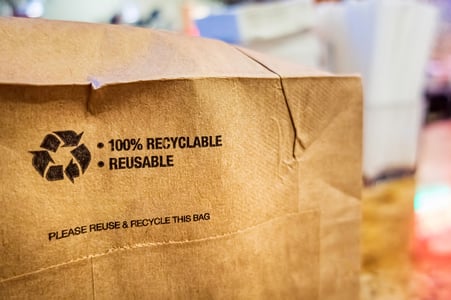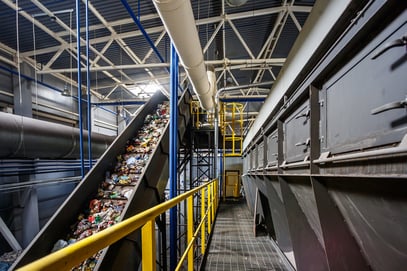Even before the big focus on the environment, it was common for the packaging industry to get a bad rap. Using non-recyclable materials, using too many materials or using single use plastics all have a negative effect on the environment and presented the packaging industry in an unflattering light.
Packaging is so prevalent in everyday life in today’s world that it has put the focus on sustainable packaging. But what makes packaging sustainable? In a recent chat for USA Manufacturing Hour on Twitter, Nathan Dube of Industrial Packaging in Massachussetts led a discussion about sustainable packaging.
The Lowest Carbon Footprint
The discussion began with participants sharing their thoughts about which packaging material has the lowest carbon footprint.
David Crysler from The Crysler Club in Michigan said, “I'm going Cardboard Boxes... Final Answer!!”
Emily Kite from Obsidian Manufacturing Industries, Inc. in Illinois said, “I would have to say cardboard!”
Adam Baker from Schooley Mitchell in Pennsylvania said, “I'll say cardboard as the lowest carbon footprint.”
Nigel T Packer from PelaTis Online in Wales, UK said, “Steel containers?”
John Buglino from Optessa Inc in New Jersey said, “Oh no, I didn't study for this test and there is no all of the above option. Uhmmmm, I do not know.”
Ruby Rusine from Social Success Marketing in California said, “Cardboard boxes are my best guess. They're biodegradable and made of paper.”
Dan Bigger from Optessa Inc in New Jersey said, “I will take Glass for 1,000.”
Dave Meyer from BizzyWeb in Minnesota, “I'm going with Cardboard?”
Kati McDermith from IndustryNet in Illinois said, “Cardboard boxes?”
Rebecca Prox from DSI/Dynamatic in Wisconsin said, “My best guess = cardboard boxes.”
Bill Garland, a manufacturing champion in New Mexico said, “Geez. I would guess cardboard or plastic wrap.”
MFG Talk Radio said, “I'd have to guess either cardboard or glass because of the ease of recycling.”
Manufacturers' News, Inc. said, “Good one!”
Brett from FreightPOP in California said, “I think it depends on what exactly is being shipped, how heavy, etc. But I'm going to go with Metal Containers! You can fit so many different things in there, and reuse them.”
Chase Bodor from Plastics Plus Technology, Inc in California said, “If we are talking production wise I think plastic. But waste included? Metal would be the least wasted.”
Host, Dube said, “While it may come as a surprise, plastic shrink film has the lowest carbon footprint. This is due the carbon produced during manufacturing, shipping, recycling or disposal during the full life-cycle of the materials.”
Proper Disposal
The discussion then turned to the correct way to properly dispose of biodegradable packaging materials. Participants shared their thoughts.
Rusine said, “We keep a trash bin specifically for biodegradable waste. Anything biodegradable is usually kept separate from the non-biodegradable bin. If possible, I sometimes keep them just in case I can use them again!”
Packer said, “It's all in the sorting. It comes with great pride to announce that as of 2019, Wales ranks 3rd in the global league tables for household recycling."
Kite said, “The obvious one but recycling.”
Meyer said, “Is there a prize for the first two wrong answers? I'm going to guess 1) Your sister's room or 2) behind your neighbor's garage (aka I don't know - this is going to be a tough week!)”
Bigger said, “Recycle them again.”
Garland said, “Recycle or composting…”
Matt Long from Aviate Creative in New Jersey said, “In the trash, or at a specialized composting facility for industrial/commercial use? I see "biodegradable" and think compost.”
Baker said, “I believe you can dissolve some of them in water but no idea on the second way....bury it???”
Prox said, “Composting and recycling?”
MFG Talk Radio said, “I throw all of mine in the recycling bin! But I've also heard of people composting biodegradable material in their yards.”
Host, Dube said, “The proper way to dispose of biodegradable packaging materials is Industrial composting facilities and Home composting piles. Bio-based packaging materials will not biodegrade or get properly recycled in single-stream recycling facilities, landfills or otherwise. For these materials to fully breakdown industrial composting or home composting is a must!”
The Most Recycled Packaging Material in the World
The next discussion point was about the most recycled packaging material in the world. Participants shared their thoughts on what they thought this packaging material was.
 Long said, “Intuitively I want to say paper, but I've been tricked by trivia too many times before. I'm going to say Steel or Plastic. Steel. Let's go with Steel. Final answer.”
Long said, “Intuitively I want to say paper, but I've been tricked by trivia too many times before. I'm going to say Steel or Plastic. Steel. Let's go with Steel. Final answer.”
Bigger said, “It has to be plastics.”
Rusine said, “I'm torn between steel for cans and paper, but I'm leaning more towards paper.”
Prox said, “I'm thinking it's paper.”
Kite said, “Is it paper?”
McDermith said, “My dad always says that brown paper bags are recycled toilet paper... Not sure he is right though.”
Meyer said, “Gotta be either aluminum or cardboard.”
He added, “I should have been slower on the draw - I don't think there's much aluminum packaging.”
Bodor said, “Plastic. Aluminum is pretty close though. Maybe even the top answer.”
Erin Courtenay from Earthling Interactive said, “Alex, "what is aluminum"? for $500”
Baker said, “I’m going with cardboard/paper on this one!”
Buglino said, “Plastic.”
Garland said, “Cardboard.”
Host, Dube said, “The most recycled packaging material in the world is metal cans. This includes steel, aluminum, and tin cans”
Issues in Single Stream Recycling
The discussion turned to what prevents recyclable materials from getting recycled in single-stream recycling. Participants shared their thoughts on the topic.
Bigger said, “Contamination of the recycled product or mixing them with other recycled products. So, sorting.”
Bodor said, “To piggyback on Dan's statement because it is spot on, some materials require specific conditions. I know one of the hardest things about plastic is that food contamination will make recyclable plastic contain unrecyclable.”
He added, “Also, some things that are *biodegradable* need special conditions too - otherwise, it turns toxic.”
Long said, “On point!”
Prox said, “Sorting problems and maybe quantity vs. capability.”
Garland said, “The number of people / companies doing it as well as contamination. I hear pizza boxes are a big problem due to the grease.”
Baker said, “One of the struggles is the mixed messaging. It used to be grease, but now they say grease is okay, but no food stuck to it. It changes all of the time!”
Long said, “Presumably this would occur if the sorting system misidentified an item, or if there was some sort of cross-contamination which prevented it from being recycled.”
Meyer said, “I'm going to go with contamination.”
Courtenay said, “I think Dave Meyer nailed it.”
Meyer said, “Truth talk: My first job was working communications for the MN Pollution Control Agency. I built the first website for the "Office of Environmental Assistance" which was later *ahem* recycled into the PCA.”
Buglino said, “Never making it there in the first place!!”
Nordman said, “Learning on this one too!”
Baker said, “Contamination?”
Rusine said, “Contamination. Cardboard, for example, can't be recycled anymore if it's say, soaked in oil or grease. Same goes for other recyclable materials used for eating/food packaging.”
Host, Dube said, “The thing that prevents recyclable materials from getting recycled in single-stream recycling is contamination. Contamination could be from liquids, food particles, breakage, or from non-recyclable materials.”
What is Sustainable Packaging
The discussion wrapped up with participants sharing their thoughts on what they think sustainable packaging is.
 Bigger said, “Anything that can be reused to avoid it being all used up, like rubber isn't.”
Bigger said, “Anything that can be reused to avoid it being all used up, like rubber isn't.”
Garland said, “Low carbon footprint packaging that can be recycled multiple times without breaking down (or just a minimal amount).”
Prox said, “Hemp would be a great example of sustainable packaging. Easy and fast to grow, easy and fast to produce as packaging, and easy and fast to biodegrade on the earth.”
Kite said, “Packaging that can be used for more than one purpose. Reusing the packaging for future orders instead of throwing it away.”
Bodor said, “Sustainability is measured by the impact on the environment for the lifecycle of the product *loose definition* Therefore sustainable packages are designed to have a significantly reduced impact, or at least are designed with this concept in mind.”
Meyer said, “Packaging that can be repurposed, reused, or at a minimum recycled. It's on a spectrum.”
Sue Nordman from Obsidian Manufacturing in Illinois said, “Better for the environment.”
Packer said, “Multi use packaging that is returned to the manufacturer and reused rather than recycled. This was the basis of the new steel coil packaging the company I worked for was developing and how I ended up with my name on 6 patents.”
Rusine said, “Sustainable packaging, in the simplest terms, is packaging that has a reduced negative impact on the environment.”
Long said, “Packaging material which has minimal impact on the environment. So materials which can be recycled or reused for future purposes.”
Host, Dube said, “Sustainable packaging is the development and use of packaging which results in improved sustainability. This involves increased use of life cycle inventory and life cycle assessment to help guide the use of packaging which reduces the environmental impact and ecological footprint.”
Wal Mart, one of the companies who uses a large volume of packaging, is credited with creating and publicizing the 7 R’s of sustainable packaging: Remove, Reduce, Reuse, Recycle, Renew, Revenue, and Read. Following these points for sustainable packaging would have a great impact on the environment both today and in the future.
********
About #USAMfgHour
Anyone who champions U.S. manufacturing can join in on a new conversation each week on Twitter using the hashtag #USAMfgHour. The chat starts at 11 a.m. Pacific Standard Time/2 p.m. Eastern. Share positive blog posts, helpful articles, news, important information, accomplishments, events, and more with other manufacturers and supporters from throughout the country.
Are you interested in hosting a #USAMfgHour chat? Contact organizers @DanBiggerUsaMfg, @DCSCinc, @SocialSMktg and @Radwell_Intl
To learn more about how Radwell International can assist your manufacturing operations

